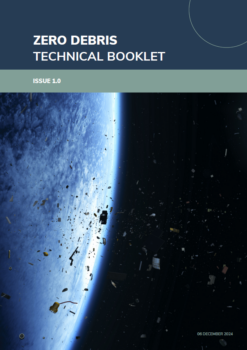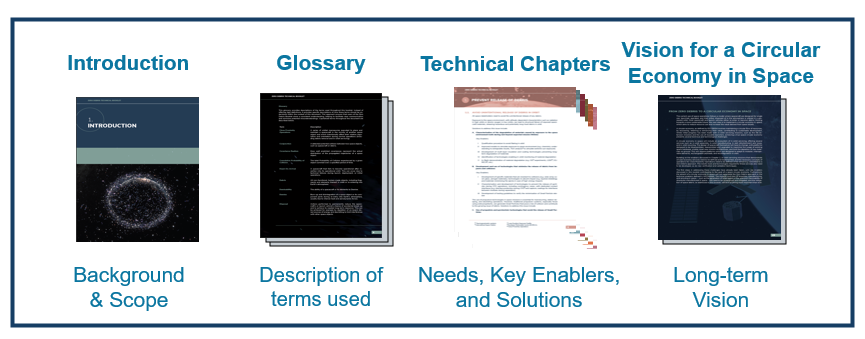Achieving Zero Debris by 2030 requires concrete technological solutions—many of which are still missing. To bridge this gap, the Zero Debris Technical Booklet was released to the public on 15 January 2025.
It is an exhaustive repository of needs, technical solutions and key enablers gathered through the Zero Debris Community to achieve, by 2030, the jointly defined targets listed in the charter. It is structured around six technical chapters, each addressing a key aspect of debris mitigation.
Constructing the Zero Debris Technical Booklet
The Zero Debris Technical Booklet was developed “by the Zero Debris community, for the community”, following a collective call to define what must be achieved to reach the goal of Zero Debris by 2030.
It was developed through a broad community effort, bringing together expertise from operators, integrators, technology providers, startups, and astronomers, ensuring a comprehensive and widely applicable approach.
The European Space Agency (ESA) acted as a facilitator, alongside other volunteer stakeholders from the Zero Debris community, while also contributing directly to the content.

The drafting process began with contributions from 36 organisations, primarily based in Europe. In May 2024, a series of bilateral meetings with 15 key stakeholders, including the European Commission, were held to gather feedback and refine the content. This was followed by a first workshop at ESOC, where over 90 industry representatives came together to discuss the technical foundations of the booklet. These discussions led to the creation of the first full draft.
Throughout the summer of 2024, an editorial working group revised and fine-tuned the text, preparing for a final workshop held in October at ESTEC, where the community provided its last round of input.

The first issue of the Technical Booklet was shared with the Zero Debris Community at the end of 2024, and was officially released to the public on January 15, 2025.
In February 2025, the first-ever Zero Debris Webinar brought the community together for an in-depth discussion of the Technical Booklet. The event featured presentations from Astroscale, OHB SE, and ESA, offering valuable insights into the document’s purpose, key challenges, and next steps.
Zero Debris Technical Booklet’s content
The Zero Debris Technical Booklet defines what needs to be achieved to reach the Zero Debris goal, while deliberately leaving the how open to foster industry collaboration—recognising that no single actor can solve the challenge alone.

The document is structured with an introduction that covers the background and scope of the project, followed by a glossary providing definitions of technical terms, and then presents six technical chapters, which outlines the needs, solutions, and key enablers as follows:
- Prevent debris release: Avoid unintentional and intentional debris release into orbit.
- Guarantee timely and successful clearance: Enhance the reliability of orbital clearance, prepare space objects for removal, and demonstrate effective removal services.
- Prevent debris generation through break-ups or collisions: Improve collision risk assessment, develop standardised evaluations of implied and encountered risks, enhance collision avoidance capabilities at the design stage, minimise risks associated with untraceable objects by design, and reduce the likelihood of internal break-ups.
- Improve space traffic surveillance and coordination: Enhance space traffic coordination and information sharing, improve space surveillance capabilities, optimise sensor tasking to reduce tracking gaps and uncertainties, and expand access to space debris catalogues to support cross-validation, knowledge-sharing, and better space traffic management.
- Prevent casualties on ground: Reduce risks to human populations and infrastructures from uncontrolled and controlled re-entry of space objects.
- Understand and mitigate adverse consequences of space objects and debris: Assess the environmental impacts of re-entry, and protect dark and quiet skies.
Additionally, the booklet introduces a vision for a circular economy in space, emphasising the role of in-orbit servicing in long-term sustainability.
What’s next?
With the publication of the first edition of the booklet, attention now turns to governance and future development.
A key priority is the establishment of a steering committee supported by technical working groups, to guide the initiative’s evolution and ensure that the Zero Debris vision becomes a truly community-owned effort. While ESA provided the initial foundation, it is now actively encouraging broader participation—fostering collaborative structures where all stakeholders can contribute their expertise, share insights, and take on leadership roles.
The ultimate goal is for the community itself to shape the initiative’s path forward, turning Zero Debris into a genuinely collective endeavour.
Ongoing discussions are exploring how the booklet could evolve—whether by deepening the technical detail or expanding the scope to address new and emerging topics. As a living document, it will continue to grow and adapt in step with technological progress and the community’s shared knowledge.
